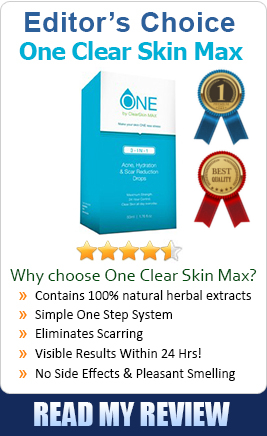Spots come in all shapes and sizes; they can be small and white, or large and inflamed. Some will affect the skin more than others, and some have the potential to damage and scar the skin. Acne spots are often referred to as acne lesions, as they bring about not only a physical change in body tissue but also physical change in the skin.
Treatment options are based on the types of lesions you are experiencing. The most common lesions include blackheads, whiteheads, papules and pustules.
Types of spots
Comedones
A microcomedone is the precursor lesion of acne and is not visible to the naked eye. It takes approximately eight weeks for the microcomedone to develop into a visible non-inflamed acne lesion; these are referred to as comedones; and develop into either a closed comedone (whitehead) or an open comedone (blackhead).
This is one reason why the full effect of acne medication is not achieved until treatment has been continued for several weeks.
This is a common definition of a comedone. It is a sebaceous follicle plugged with dead skin cells, sebum, tiny hairs and sometimes bacteria. When the comedone is closed, the bacteria and sebum stay trapped below the skin surface, and at this stage it is commonly referred to as a whitehead because of its white appearance.
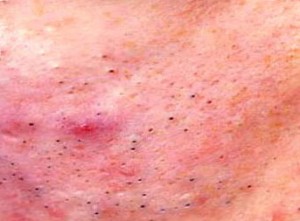
Blackheads
Blackheads occur when the pore is only partially blocked, so some of the sebum, dead cells and bacteria are drawn to the surface. Contrary to popular opinion, the black appearance is due not to dirt but to the oxidizing of the substances in the pores, causing them to darken. Blackheads can take quite a long time to clear.
Macrocomedones are facial closed comedones also known as whiteheads, and they are usually
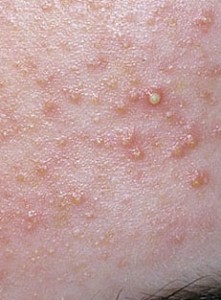
Whiteheads
about 2-3 mm or larger in diameter. Solar comedones appear on the cheeks and chins of older and elderly adults and are usually a direct result of prolonged sunlight exposure.
Papules

Papules
These are inflamed small (less than 5 mm in diameter) red tender bumps with no head. You may find a group of them in one area on the skin. They have a bumpy, sandpaper feel, but can be almost invisible to see. They are often referred to as pimples.

Pustules
Pustules
These are very similar to whiteheads but are inflamed dome-shaped lesions. Appearing as red circles with a white or yellow centre, they consist of a mixture of white blood cells, bacteria and dead skin cells. Pustules are very common and are most often seen on the face, shoulders, back and breastbone.
They can also be found in areas where excess sweating occurs, such as the armpits or the groin. Generally these pustules will heal without scarring if they do not progress to cystic form.
Macules
A macule is the red inflamed site left by a healed acne lesion. Luckily it is only temporary, although it may persist from a few days to several weeks or months before it disappears. If a number of macules are present at the same time, then they contribute to the ‘inflamed face’ appearance of acne.
Nodules
These are much larger than the other types of acne lesions already mentioned. Similar to papules,

Nodules
they are solid, dome-shaped or irregularly shaped lesions. Unlike papules, though, they can affect the deepest layers of skin with their inflammation. They can be felt as large hard bumps under the skin, and often are the result of a blocked sebaceous gland that bursts.
The inflammation then spreads into surrounding tissue, where it damages the tissue and may lead to scarring. Nodules can be terribly painful and tend to last much longer than blackheads or pus-filled spots, usually for months at a time. These types of lesions can be very resistant to treatment.
Cysts
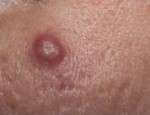
Cysts
An acne cyst is a sac filled with liquid or semi-liquid material, consisting of white blood cells, dead cells and bacteria. Cysts have a diameter of 5 mm or more and are usually present, together with nodules, in a severe form of acne known as nodulocystic acne. Cysts can be very painful, and scarring is often the end result.
Types of acne
Acne comes in various forms. The most commonly known one is Acne vulgaris, thus the name as ‘common acne’, is typically the type most teenagers suffer from. This can persist into adulthood too. With this type of acne there are always whiteheads or blackheads or both, and many people have some experience of this form of acne at some stage of their life.
However, there are different stages or categories of Acne vulgaris, which include mild, moderate and severe, and there are also several types of lesions. The individual lesions of Acne vulgaris are divisible into three types:
- Non-inflamed lesions, which include open and closed comedones;
- Inflamed lesions, which may include papules and pustules;
- Scars: in most cases nodules are associated more readily with scarring, but cysts can also lead to scarring.
Mild acne
This is generally the type most of us suffer from at some stage, and if you are lucky and treat it early enough then it may well not develop further. Mild acne consists of several types of lesions, characterized by comedones, more often than not affecting the chin and forehead. Pustules and papules are rare but may be present.
Moderate acne
If acne does develop, it’s often because treatment was not immediate. Although similar to mild acne in that it has comedones, papules and pustules, moderate acne is also characterized by more painful and deep-rooted lesions. It usually needs to be treated by a dermatologist to prevent it leading to severe acne.
Severe Acne vulgaris
This is characterized by deep-rooted inflammatory lesions, including nodules and cysts, which are painful and may cause scarring. If the inflammation is deep and severe or the spot is squeezed, it may bursts deep inside the skin’s tissue and spread inflammation, causing swelling and pain.
The face and sometimes the body can be covered in lesions – not only is this painful but it can lead to psychological problems, including depression and loss of self-esteem. Very often this type of acne affects an individual’s quality of life, including his or her social life and even employment.
Severe acne is much more difficult to treat than mild or moderate acne. It may last for years and requires aggressive treatment, but options are limited and treatment must always be by a dermatologist.
Other forms of acne
Acne conglobata

Acne Conglobata
The majority of those with Acne conglobata are men aged 18 to 30. It is a very severe form of inflammatory acne, the lesions are found on the face, chest, trunk, arms, back, buttocks, and even the thighs.
Characterized by large lesions that often inter-connect, it includes comedones, pustules and cysts filled with pus. Unfortunately, it causes wide-scale scarring due to the deep ulcers that form under the nodules and burrowing abscesses. This can sometimes lead to disfigurement and long-term damage of the skin, as well as psychological problems.
Acne conglobata can flare up after lying dormant for years. This form of acne requires expert medical care and is usually treated with isotretinoin (a derivative of vitamin A), corticosteroids and antibiotics. Several courses of treatment can be necessary over a period of years, and frequent routine check-ups by a dermatologist are necessary to look for signs of recurrence.
Acne fulminans

Acne fulminans
Also known as Acne maligna, this is another very severe form of inflammatory acne usually affecting teenage boys, but it can be also be seen in young adult males. It is characterized by a sudden acute onset of inflammation in existing acne, which can occur after unsuccessful treatment of Acne conglobata, and is accompanied, by a sudden onset of fever, loss of appetite, atrophy and wastage of the muscles, and pain in the joints.
In fact, this acne usually begins with pain and swelling in the joints, which then affects the lymph nodes in the neck. The lesions, which tend to appear on the face, chest and back, include inflamed nodules and cysts, which often become crusted and ulcerated. Unfortunately, this form of acne can lead to extremely disfiguring scarring.
Acne fulminans is accounted as an immunologically induced disease, with elevated levels of testosterone, sebum and P.acnes bacteria. The treatment for this severe form of acne can be very aggressive. If treatment is not sought early enough hospitalization may be needed.
Isotretinoin, corticosteroids and non-steroidal anti-inflammatory medication to help reduce inflammation are the most suitable treatment options. However, the psychological damage from this type of acne may be severe.
Gram-negative folliculitis

Gram-negative folliculitis
An uncommon form of acne, gram-negative folliculitis is an inflammation of the follicles, giving the appearance of a pustular rash but with very few comedones or papules, and is caused by a bacterial infection.
Because of its appearance it can often be mistaken for a flare-up of existing acne, and very often develops as a complication after long-term antibiotic treatment for Acne vulgaris or rosacea.
The bacteria in this form of infection tend to be resistant to most types of antibiotics, and therefore a dermatologist will usually have to consider isotretinoin as a treatment option.
Nodulocystic acne

Nodulocystic acne
This form of acne is characterized by cysts that can occur singly or be widespread over the face, neck, scalp, back, chest and shoulders, and may be extremely painful. Unlike other types of cysts that are an abnormal dilation of normal skin structure, there are nodules of inflammation arising from an acne lesion.
They are filled with thick yellow pus-like liquid and may need to be drained by a doctor when treatment is ineffective. When the cysts occur close together they produce a soft area undermined with tunnels, cell destruction and inflammation, resulting in Acne conglobata.
Treatment for nodulocystic acne requires antibiotics and isotretinoin, or in some cases intralesional corticosteroids that ‘melt’ the cyst over a period of three to five days. If this form of acne is left untreated, scarring may occur.
Adult acne
Unfortunately, acne doesn’t confine itself to the teenage stage of life. Many adults find themselves experiencing acne, sometimes for the first time, into their mid-twenties and upwards. According to the British Association of Dermatologists, the median age of those with adult acne is now around 30, and acne persisting beyond the age of 25 is likely to continue for 10-20 years.
Whereas teenage acne tends to present along the forehead, nose and chin, otherwise known as the T-zone, adult acne is more confined to the cheeks, jawline and neck, and the lesions tend to be deeper and more cystic.

Adult acne
Its puzzling among dermatologist as they are trying to reason out for the rise of adult acne. Some dermatologists believe that more adults are developing acne, while others believe more adults are admitting to acne and seeking treatment for it. Perhaps a compelling case can be made for both theories – it is more than likely both are true.
A recent study showed that 54 per cent of men and 40 per cent of women over the age of 25 are affected, although there are several theories as to why acne should be on the increase in adults. It may be due to small hormonal fluctuations that cannot be detected by routine blood tests.
It is also possible that there may be an alteration in the responsiveness of the hair follicle, and/or a decline in serum levels associated with ageing.
Diet and synthetic hormones, found in food and the environment, are also thought to contribute to the increase in cases of adult acne, as is stress, a modern-day curse of our lives. Typically, work, a new job, exams and relationships during the period of life from the mid-twenties to the mid-forties are recognized as common stress triggers and play a major role in today’s modern living.
This tends to be a vicious circle – acne causes stress and low self-esteem, and stress aggravates acne.
Just as teenagers with acne may find it affects their social life, so too does adult acne affect the lives of older people. Only recently have doctors and mental health experts realized that acne suffered by adults is likely to have much greater long-term social, physical and psychological effects (including depression) than teenage acne.
Dermatologists agree that adult acne is much more likely to leave physical scars: it is more prone to scarring than teenage acne, as the ageing process reduces the skin’s collagen; scars will not heal as well as in young skin; and many adults are so self-conscious about their acne that they find it difficult to admit to it, and may not seek treatment until too late.
Here is a typical scenario of an adult who is suffering from adult acne. Tom, 34, admits to this problem.
I was finding myself in a new and challenging position at work after being promoted to manager of a department and expected to deal with clients and staff on a face-to-face level. Waking up with the odd spot wasn’t too much of a problem, but by the time I admitted to myself that I was experiencing acne, the spots have covered my face and developed into a red mass of inflamed spots.
I was so self-conscious that I just couldn’t face going into work. It was my girlfriend who persuaded me to see the doctor. She had bought some over-the-counter products, but I admit I didn’t stick to the instructions very well. She told me I was becoming moody and had changed: we used to be very sociable but I was making excuses about being busy with work that I had to do at home in the evenings and at weekends – anything to stop us having to see anyone.
I went to the doctor one day after I had phoned in sick. He was really sympathetic and told me that the stress of my job had probably brought about my acne. I had it quite badly as a teenager. He put me on a course of antibiotics, and within eight weeks I could see the improvement.
He told me to take some exercise as well, to help me reduce stress levels, so I took up jogging again. I feel much better about myself now, and although my face is not completely clear, it is so much better. I think it will eventually clear up completely.
My girlfriend is happier, and we are back out seeing people again. I just wish I had done something about it sooner – the last year has been awful and it was unnecessary to suffer for so long.
If you were prone to acne as a teenager, then the chances are that acne is more likely to recur in later life. While the acne may not be as severe as during your teenage years, it’s a hard fact that adult acne can sometimes be more difficult to treat – though not impossible.
Luckily, more adults are now prepared to seek treatment for their acne rather than just putting up with it, so doctors are at last seeing acne as an adult problem. It’s encouraging the medical world to take more notice of acne, helping to promote a greater awareness and new hope.
For the best results, do make sure you visit your doctor as soon as possible. As with all acne, early treatment is effective treatment.
Adult female acne
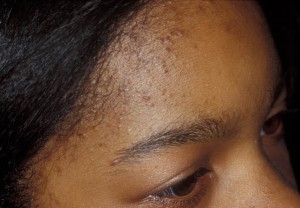
Comedonal acne
Many women may find acne suddenly occurs during their twenties, thirties and forties, and although it is generally less severe than teenage acne, it can be more challenging to treat. Female adult acne is characterized comedonal acne on the forehead and cheeks, inflammatory papules or nodules on the lower part of the face, chin and neck.
While some women will continue to have persistent teenage acne, others who experience a sudden onset of acne may find it is due to underlying health conditions. A woman suffering from hyperandrogenism – the excessive production of androgen hormones – may have an abnormality of the endocrine system, which controls hormone production.
This is turn can often be associated with serious health conditions such as infertility, heart disease and diabetes. Polycystic ovarian disease, where the ovaries do not function properly, may be another underlying cause of female adult acne.
Stress is also an important factor in acne, according to experts such as Professor Tony Chum consultant dermatologist at Hammersmith Hospital: stressed career woman in their thirties and forties are typical of those who attend his clinics, desperate for treatment.
Perhaps, though, the most common reason for female acne is the constant hormone changes a woman experiences throughout her lifetime, which is hardly surprising when the relationship between acne and hormones is so closely intertwined.
From puberty to regular menstruation, oral contraception (the progesterone-only pill is a common culprit of female acne), pregnancy and the menopause – these life events demand surges of hormonal changes that may trigger acne breakouts.
Typically, nearly half of all adult women find that spots appear a week before menstruation. The decrease in oestrogen and rise in testosterone before bleeding is thought to increase sebum production, while also increasing the size of the pores and stimulating the follicles to form acne.

Acne during pregnancy
Even pregnancy does not let you off the hook: just when you thought you might be entitled to the so-called ‘bloom’ of pregnancy, that glow is in fact due to the increase in hormones, which also increase oil production and hence spots.
Indeed, for some women, pregnancy can be their first experience of acne. Of course, just because you are pregnant does not mean you will necessarily get acne – in fact, some luckier woman find it actually clears up their regular acne!
For those who do experience acne during pregnancy, especially the first trimester, or first three months, is when spots are more likely to break out. They don’t just affect the face but also on the chest and back. Usually as the pregnancy period progresses, increased oestrogen levels help to clear up acne.
A few women will be unlucky enough to experience acne at both the start and end of pregnancy, because of the change in hormones as the body prepares for birth and raised hormone levels to sustain milk production for breast-feeding. The whole period is a hormonal roller-coaster, and little wonder that the hormones can spiral out of control. This process for some women may be repeated in further pregnancies.
Once the family is complete, a woman may need contraception, and the oral contraceptive pill Dianette is commonly prescribed to treat female acne. Pregnancy acne can be difficult to treat too, as many over-the-counter products cannot be used during pregnancy for fear of harm to the developing foetus. You must check with your doctor before using any products on your skin at this time.
Caution: If you already have acne and are planning to become pregnant, then you must discuss your treatment options with your doctor or dermatologist, as certain acne medications may be damaging to the unborn child.
As a woman ages, so her hormone production changes once again. The menopause, a period of time when hormonal changes occur and the fertility diminishes, is well known for its hot flushes, mood swings, headaches, insomnia and loss of skin elasticity, but not nearly so much for its acne.
It can be a challenging period for some women from the ages of 45 to 60, lasting years in some cases as the ovaries gradually decrease their production of oestrogen, sometimes erratically. The last thing you need as you get older is a case of menopausal acne, especially if you haven’t had a spot since you were n your teens, yet this is just what some women experience, along with itchy, flaky skin, a skin condition known as seborrhea and closely linked to acne.
It is thought that the decrease in oestrogen during this period of life is responsible for the outbreak, giving rise to an increase in androgens. Luckily, menopausal acne responds well to conventional acne treatments, especially vitamin A, but bear in mind that hormone replacement therapy (HRT), often used to help alleviate the other symptoms of the menopause, can sometimes cause an outbreak of acne. Best of all, menopausal acne tends to improve and disappear once the menopause is over.
Rosacea

Acne rosacea
Rosacea is a chronic, rash-like skin condition that can often look similar to Acne vulgaris, so sometimes causing problems with diagnosis. In addition, it tends to arise at the same time as an acne outbreak, hence making the condition even more difficult to diagnose.
Unlike acne, however, there are no comedones; instead, it is characterized by its red, inflammatory appearance. Rosacea can cover the cheeks, nose, forehead and chin, causing swelling and red bumps, and the dilated blood vessels can become more visible on the skin’s surface.
Unfortunately, rosacea is often mistaken for flushing, and this appearance of blushing can add to the misery for those with the condition.
Although it affects both sexes, it is three times more likely to affect women, though it tends to cause worse symptoms in men. It can affect any age group, but is more common in the 30-60 age range. Rosacea has a hereditary link and tends particularly to affect people who are fair-skinned, with light hair and blue eyes.
As well as affecting the skin, it can also cause other problems such as dry eyes and sore eyelids. Left untreated, it can sometimes cause swelling of the nose and the growth of excess tissue, resulting in a condition known as rhinophym, a bulbous nose.
Because of this, and because of its similarity to acne, it is important for a doctor or dermatologist to diagnose the condition, as treatment for both skin conditions is very different. Do however; remember that acne and rosacea can co-exist, so the doctor has to be vigilant in making the correct diagnosis.
Pyoderma faciale
Also known as Rosacea fulminans, Pyoderma faciale is a very rare form of acne that usually only affects females between the ages of 20 and 40. This unusual skin condition, found only on the face, cheeks, chin and forehead, is characterized by large painful nodules, pustules and sores.
Unless aggressive treatment is immediately started, it may leave scarring. It can occur suddenly, sometimes overnight, without the person ever having had acne before, and although it is not fully understood it is thought to be a result of a severe reaction in which the hair follicles become engulfed in inflammation, thought to be induced by stress.
It is often confused with severe acne and is deemed to be an explosive form of rosacea, but unlike severe acne it does not arise from comedones, and unlike rosacea it is not associated with blushing or flushing. Treatment often includes steroids, for their anti-inflammatory action. Pyoderma faciale usually lasts no longer than a year.
Corticosteroid acne
A side-effect of using oral steroids can be pustular acne on the face, chest, back, arms and thighs. Inhaled corticosteroids, such as those used in asthma inhalers, may also induce acne.
Acne cosmetica
Comedogenic cosmetic, skin, and hair products cause this form of acne, which results in small red bumps commonly found over the forehead, face, cheeks and neck. This acne is generally easy to treat once the product is identified and changed.
Acne mechanica

Acne mechanica
This acne occurs from constant pressure, heat, covered skin and repetitive friction against the skin. For example, if you ride a horse or a motorbike or play sport where you are required to wear a helmet with a chinstrap for a relatively long period of time, then your head and chin will become hot and sweaty, and an outbreak of spots may appear on your forehead and chin.
Soldiers may develop Acne mechanica on their backs and shoulders from carrying backpacks and equipment, and if they are posted to hot or humid environments, the acne can develop further, becoming irritated and inflamed.
Musicians, particularly violinists, may find acne breaks out on their neck due to the violin being tucked and held against the neck for hours at a time; a similar effect can be caused by your mobile phone being held for long periods against your neck.
Even underwear can cause acne: tight bra straps and tight pants can encourage spots on the back, thighs and bottom, and synthetic fabric will make Acne mechanica worse as it traps the heat against the body.
Acne mechanica spots can vary in appearance from small undeveloped microcomedones that are not visible on the skin but are rough to the touch, known as sandpaper acne, to inflamed pustules and papules. Luckily, Acne mechanica responds well to treatment, which usually includes removing the offending cause of the problem, but this is not always possible.
However, Acne mechanica responds well to salicylic acid or benzoyl peroxide treatments and the wearing of cotton fabrics, but do consult your doctor if after several weeks of treatment it is still a problem.
Acne excoriee
Excessive scratching or picking at spots will result in this form of acne, which is often referred to as ‘picker’s acne’. Although tempting, squeezing spots does more harm than good and can leave scars and hyper pigmentation.
It tends to be more common in females, particularly adolescent girls, and can be a sign of depression, anxiety or emotional problems. Often, what may begin as a mild form of acne becomes severe and prolonged from constant picking.
It can be found on the face, back, chest, breast, back and upper arms. If the inflammation becomes infected, then the skin may become scarred. One of the distinguishing signs of Acne exoriee in hyper pigmentation of the skin: brown spots are the scars left on the skin from previous blemishes that have been picked to the point of tissue damage.
Chloracne
This is an acne-like condition characterized by blackheads, pustules and cysts, and the lesions are generally found on the cheeks, behind the ears and in the armpits and the groin area after exposure to chlorinated hydrocarbons, such as dioxins or PCBs.
Direct skin contact with these chemicals, known as chloracnegens, and inhalation and ingestion are considered possible routes by which this acne develops.
Acne neonatorum or infantile acne
Newborn babies can get acne; some are even born with it, although it mainly affects babies from around the age of three to four weeks. In general, small whiteheads appear over the cheeks, forehead and chin, although there can also be red bumps or pimples or even nodules.
It tends to be more prevalent in boys than girls. Testosterone passes from the mother’s blood via the placenta and activates the sebaceous glands very early in foetal development. Babies are born with active sebaceous glands and therefore can develop acne.
It usually settles down and disappears after a few months, generally between four and six months, but it is common for babies who suffer from this condition to have a tendency to develop acne again in their teenage years.
Usually no treatment is necessary for this type of acne, and cleaning with oils and lotions may irritate the baby’s skin further; however, as with all acne, the earlier it is seen by your doctor, the better.
Perioral dermatitis
Tiny papules, red bumps, pustules, yellow pus-filled spots ad scaling of the skin are the main characterizations of this type of skin condition, which tends to affect young women. It usually presents around the mouth and chin, and may spread to the eyelids and forehead.
Perioral dermatitis is very itchy and it is commonly mistaken for acne. While the cause is not clearly understood, dermatologists believe it is a form of rosacea. Strong corticosteroid creams used for other facial skin problems can cause perioral dermatitis, as can fluorinated toothpaste, facial creams, make-up and moisturizers.
Scalp folliculitis
Acne that develops around the scalp and hairline is known as scalp folliculitis. It is an inflammatory disorder of the hair follicles in the scalp. It is also known as Acne necrotica miliaris or proprionibacterium folliculitis.
The scalp becomes dry, flaky and itchy; the itching is usually the main reason it is difficult to treat, as the lesions become sore and crusty from being scratched and are difficult to clear.
Acne necrotica is a more severe form of scalp folliculities and can affect other areas of the skin including the face. It can also scar.



